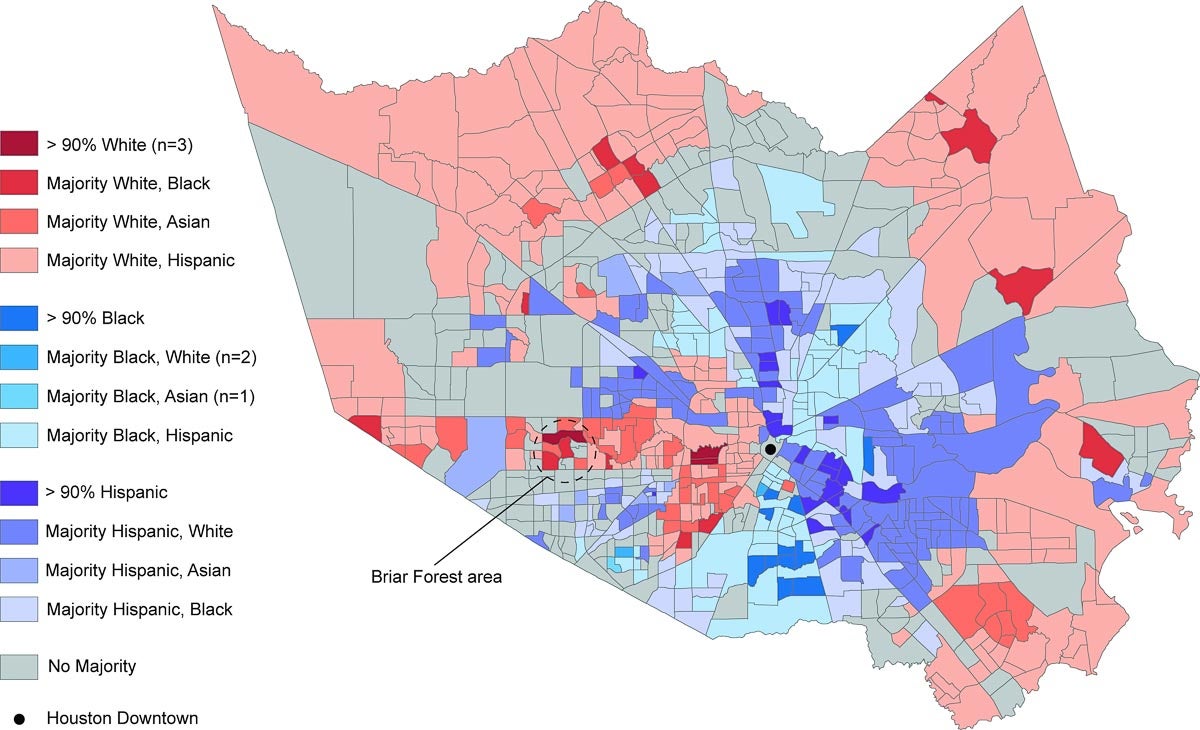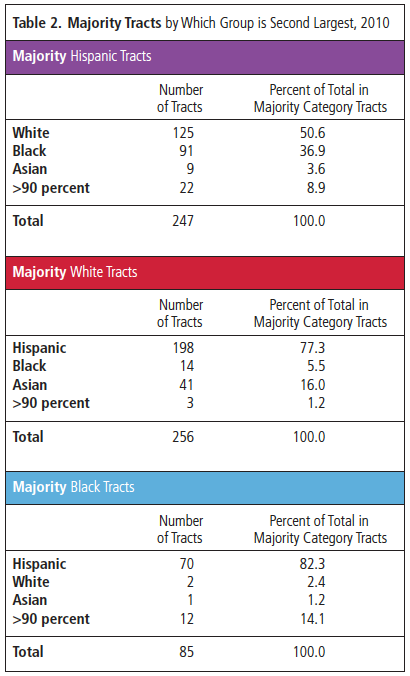White people in Harris County are more likely to live in Hispanic neighborhoods in large numbers than in black neighborhoods, according to a new report from Rice University’s Kinder Institute for Urban Research that sheds light on the shifting racial composition of Houston-area communities.
"The Shifting City: Houston's History of Unequal Racial Change," by Kinder Institute postdoctoral fellow Heather O'Connell, offers a twist on the traditional analyses we often see of neighborhoods. We've all seen maps that show which race or ethnicity is the largest group in each census tract across a city.
But O'Connell took that analysis a step further, examining which is the second-most populous group in each tract too.
The map below shows Harris County's breakdown, based on 2010 Census figures. Click for a larger version.
(Article continues below map)

Immediately, stark patterns start to emerge. The "arrow" across west Houston, which represents majority-white areas, is crystal clear. It's also obvious that north, south and east Houston are divided into "pie slices," alternating between majority-black and majority-Hispanic areas that emanate from the central part of the city. And it's readily apparent that many areas on the periphery of the city and beyond have no racial majority at all.
It's a useful analysis that goes beyond a surface-level examination of which group is predominant in a particular area. "When we think about differences across neighborhoods -- the quality of schools, proximity to supermarkets, etc. -- those differences are going to relate to racial/ethnic composition," O'Connell said. "But, in Houston, that racial/ethnic composition is more complex than a singular majority, so we risk missing real neighborhood disparity if we don't represent it correctly."
But the analysis in Houston also reveals an interesting trend about the way whites, blacks, and Hispanics coexist in a city so frequently labeled the "most diverse in the nation."
- Majority-Hispanic neighborhoods are likely to have whites or blacks as the second-most populous group in the area.
- Majority-white neighborhoods are likely to have Hispanics as the second-most populous group. It's unlikely blacks will be the number two group in a white neighborhood.
- Majority black neighborhoods are likely to have Hispanics as the second-most population group. It's unlikely that whites will be the number two group in a black neighborhood.
The chart below breaks down the numbers more precisely. (Article continues below chart)

Via Kinder Institute
Why have those patterns emerged? A lot of it may have to do with the broader racial/ethnic shift that's occurred in the region in previous decades as the Houston area's Hispanic population has exploded.
In 2000, Harris County was 42 percent white and 33 percent Hispanic. A decade later, those proportions had almost exactly flipped. With such a large, and growing Hispanic population, perhaps it's to be expected that, regardless of community type, Hispanics would often -- at a minimum -- be the second-largest group.
That's not the whole story though.
"Yes, Hispanics are the most-likely second group, especially today," O'Connell said. "But the small cross-pollination between whites and blacks in Harris County was also true prior to Hispanics mass increase. So there's definitely something else going on."
"White-black segregation is the highest across the nation, even in places where Hispanic populations are small," O'Connell said of Harris County. "And even in earlier decades in Harris County, when the Hispanic population was smaller, the stark divisions between where whites and blacks live persisted."
The Kinder Institute will explore how these patterns emerged -- and, importantly, their implications -- through the ongoing work of its new Urban Disparity and Opportunity program.
